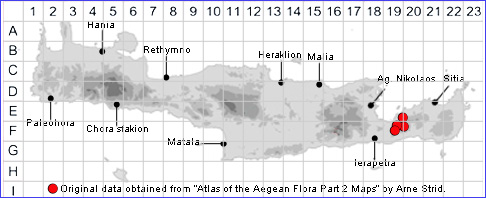
HELICHRYSUM DOERFLERI
Family and Genus:- See- COMPOSITAE/Sect. VIRGINEA
Common Names:- None
Homotypic Synonyms:- None
Meaning:- Helichrysum (Gr) Golden-sun.
Doerfleri (L) Possibly for the Austrian botanist Ignaz Dorfler (1866-
1950).
General description:- Perennial tufted (caespitose) plant, covered in soft hairs.
Stems:-
1) Flowering stems not more than 8 cm, decumbent or ascending from the woody
base, tomentose
Leaves:-
1) White-tomentose. petiole with a swelling either proximal, distal or both.
2) Basal, 5-10(-15) x 2-3 mm; oblong-spathulate.
3) Cauline, numerous:
a) lower, 20-30 x 2-4 mm, oblanceolate-spathulate, acute.
b) upper, narrowly linear.
Flowers:-
1) Capitula, small yellow (1-)2-4.
2) Bracts:
a) outer, forming a cup or ruff surrounding the involucral bracts ovate.
b) Inner, lanceolate becoming erose or irregularly lacerate at the apex.
Key features:-
1) Rosette-leaves, 5-10(-15) mm; lower cauline leaves 20-30 x 2-4 mm .
Habitat:- Calcareous open rocky ground, often beneath spiny dwarf shrubs 800-
1400 m.
Distribution:- Endemic Afendis Kavousi & Mt. Bembonas. Rare.
Flowering time:- Apr to mid-July.
Photos by:- Steve Lenton
Status:-
Conservation status (for threatened species):-Vulnerable according to IUCN 1997.
Protection status (for threatened species):-Greek Presidential Decree 67/1981.
SPECIES DESCRIPTION
